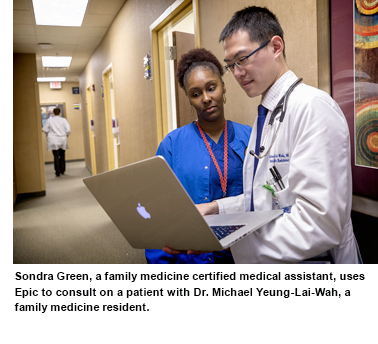Enhancing Our Digital Domain
Good morning!
Today I’ll talk about two of our largest investments in technology platforms – one familiar and the other brand new.
These are Epic and Workday.
 As everybody involved with our clinical mission should know by now, we’re gearing up for the so-called “rebirth” of Epic this summer – July 22 to be exact. This will be an upgrade from Epic 2015 to Epic 2018, but it won’t be just a simple change to a new and improved version. We’re taking the opportunity – and mobilizing more resources – to do a much deeper dive on training, customizing the software for the diverse settings where it’s deployed, and making Epic easier and more functional for users.
As everybody involved with our clinical mission should know by now, we’re gearing up for the so-called “rebirth” of Epic this summer – July 22 to be exact. This will be an upgrade from Epic 2015 to Epic 2018, but it won’t be just a simple change to a new and improved version. We’re taking the opportunity – and mobilizing more resources – to do a much deeper dive on training, customizing the software for the diverse settings where it’s deployed, and making Epic easier and more functional for users.
Ever since we installed Epic in June 2012, shifting from paper to an electronic health record in one fell swoop, our Epic team has been working with clinicians to optimize the system to enhance the user experience.
We’ve come a long way in nearly six years. I remember receiving an email on the fifth anniversary of the Epic “go-live” from a longtime faculty member who had been a vocal Epic critic. I won’t say he’d become a total convert, but he did remark how convenient it was to be able to pull up scans and upcoming appointments for his patients during their visits and that, all in all, Epic seemed to be a useful tool.
In a recent Leadership Rounds, our regular rounding group was joined by about a dozen members of the Epic team. Frontline staff in the units we visited were asked what aspects of Epic annoyed them — what gave them a “Grrrr” moment. I remember one nurse complained about having to enter login credentials three or more separate times to access Epic. A possible solution: The rebirth will pilot a “tap and go” feature that will allow clinicians to log in with their badges.
Simplifying Epic, enhancing the user experience, making technical support more readily available – these are important objectives in their own right. But the ultimate goal is to make Epic less intrusive, yet still highly functional, in the clinical setting so our health care teams can devote more time and energy to their patients.
Our Epic team has been interviewing users to collect information about their experience, but they'd like to hear even more. We are working with a national group, the KLAS Arch Collaborative, to conduct a survey of all our Epic users to guide future actions. Respondents can participate anonymously. If you are an Epic user, you may access the survey here.
While our work continues on Epic, we are making another huge software transition in the system that supports many of our business functions. Lawson, which has been in place for about a decade, will gradually be phased out and replaced by another product, called Workday. The transition has already begun and will continue toward full implementation during the next three-and-a-half years.
When we adopted Lawson as our enterprise resource planning software, I was asked to be the executive sponsor. My main memory of that time, other than the steep learning curve I experienced, is that it allowed me to meet many people who had not previously crossed my path at UMMC. I learned so much about the operations of the Medical Center and came to understand and appreciate the massive amount of infrastructure required to run it.
Although change always brings about a certain level of angst, I’ve heard nothing but good things about Workday, so I feel like this transition will be well-managed and well-received.
Both Epic and Workday represent multimillion-dollar investments in tools that allow us to work better and faster in many phases of our operations. Beyond what we experience as individual users, they provide so many benefits in terms of the aggregated data that is available for analysis, research and record-keeping.
What we have to remember is they are simply tools. They cannot replace human interaction – be it how we work and communicate with our patients or with each other – on our journey toward A Healthier Mississippi.



